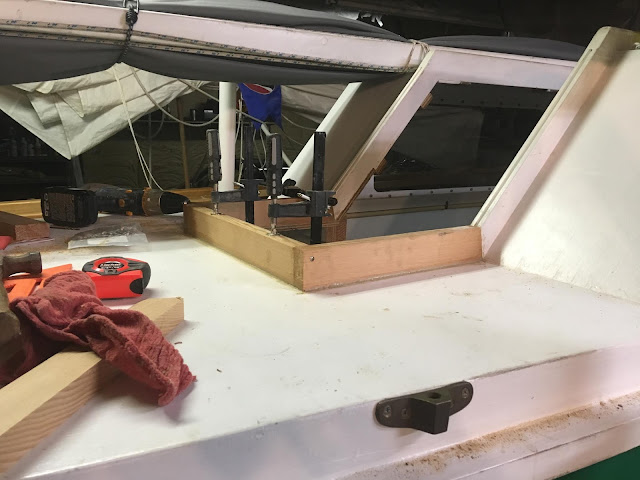I've finally finished detailing everything after cutting in the additional hatch for the motor access, which has been working out great. It also really helps working the aft end of the boom when rigging the boat or reefing/furling the sail. Tall people might not need it, but if you're 5'8" or less I highly suggest you make this mod if you build a Robbsboat. It makes things much safer and more convenient.
The bungee on the bottom holds the rudder down in lieu of Jim's chunk of lead. Slightly fidgety getting the tension right, but works well once you do. Uphaul run on top of the tiller. The bolt through the end is to prevent splitting after I installed the fitting for the Ronstan tiller extension on the end, I should have pre drilled for the screws even though they're only #6. Live and learn.



The second thing that was wearing on me was stepping the mast through the deck. I've only got 16ft instead of the originally designed 18ft, but it can still get a little interesting balancing things as you lift it high enough to get over the deck and then reach forward to insert it. Definitely not something I've ever wanted to do while actually on the water. I suppose if one were to find some nice light spruce or take the trouble to build a hollow mast it wouldn't be so bad, but like the aft hatch mod I wanted to make it super safe and easy. As a result I brought the step to just the other side of the front bulkhead and into the cabin, so now I only have to lift it a few inches over the cabin sole to step it. The only drawback is it's going to be more difficult to keep things in the cabin water tight in a good rain.
Had to cut 4 of my ballast bars to allow for the heel of the mast to reach all the way to the floor of the boat. I wanted the step firmly affixed down by the dimensional lumber of the bulkhead.
Notching the front of the cabin was simple and it's plenty strong enough to act as a mast partner as the mast is right up against the bulk head. The retainer plate was simple as well, and is held in place with a couple of 5/16" bolts with wing nuts on the bottom.
The pad eye on the mast is to anchor the downhaul. the hole you see near it is where the running end of the downhaul runs into the cabin where i belay it against the mast. While the partner shear loads are easily handled, I didn't want the heavy downhaul tension pulling straight up on the cabin after taking the center out. All of that load is taken by the mast, and I can adjust downhaul tension without removing the front hatch if necessary this way.
The old step is still there to use if I want, but it makes a handy place to run an anchor rode into a bucket below. While cleaning up the garage, I found a dorade that fit pretty much perfectly into the hole with just some minor clearancing with my dremel. The "unfinished" mast is just a short section I glued up for test fitting everything inside the garage.
Lastly I need to build a new front hatch. The lexan in the existing one come down too far too notch, but luckily I have some pretty thick acrylic laying around that I had originally thought I could do all of the cabin windows with. Turned out to be a poor choice for that, but it's working out great as a hatch material.
I still need to trim out the top of the notch to make spray and rain running down the hatch go around the opening. I also need to get some shock cord attached to the bottom of the wood rails to secure the hatch to the thumb cleats in the cabin, but it's pretty much done.
I'll need to find the right position of the sail for helm balance now that I've moved the mast back @ 5". Jim designed the mast with about a 5 degree rake aft in the original position, which actually puts the mast tip a bit behind where it's sitting now. I rigged the step and partner for the mast to be straight up and down, so it shouldn't be an issue.
Time to Vacuum all of the sawdust and put the interior back in order. Again.....
Hopefully the weather cooperates this coming weekend so I can get her out on the water and do that. Only 39 more days to the Salish 100....


























































